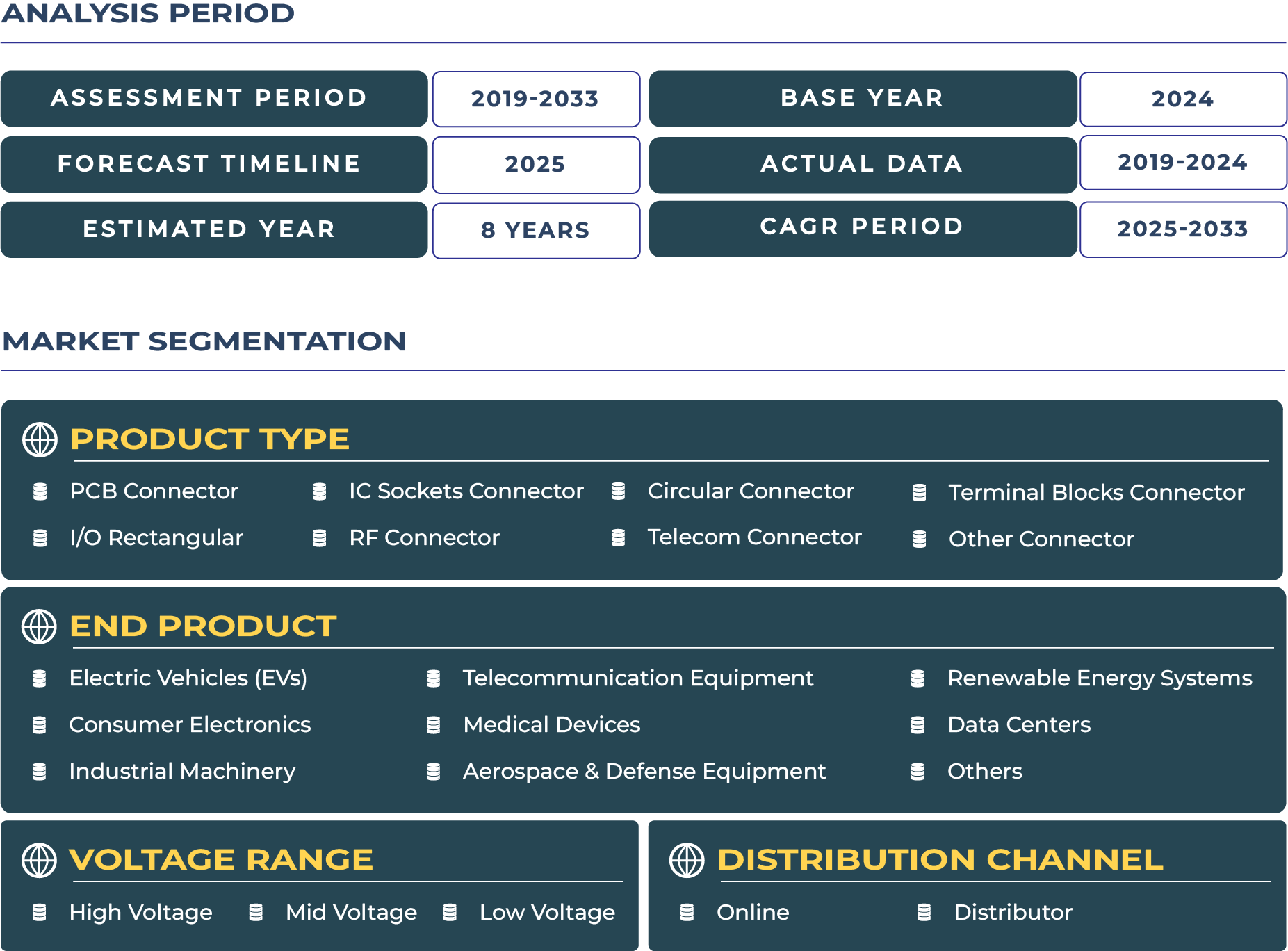Saudi Arabia Connector Market Outlook
Saudi Arabia connector market is entering a phase of rapid transformation, fueled by the nation’s strategic focus on digital infrastructure, clean energy, and industrial diversification. With the Kingdom committing over $5.3 billion to cloud infrastructure through initiatives such as Amazon Web Services’ upcoming data center region by 2026, the demand for high-performance connectors is witnessing an unprecedented surge. According to David Gomes, Manager – Semiconductor, these infrastructure investments are unlocking a robust compound annual growth rate (CAGR) of nearly 8.2% during the forecast period, as businesses and government agencies look to scale connectivity with precision, resilience, and energy efficiency. This momentum is underpinned by Saudi Arabia's broader Vision 2030 objectives, which aim to reduce oil dependency while fostering digital and industrial innovation.
The hyperscale data center ecosystem in Saudi Arabia is one of the primary catalysts shaping this market. With a national goal to achieve over 1,300 MW of data center capacity by 2030, players like Al Moammar Information Systems and AWS are leading the charge. The Al Moammar expansion to 64 MW and AWS’s three new availability zones are just the beginning. These facilities require not only scalable power and cooling systems but also specialized copper and fiber connectors capable of supporting high-throughput, low-latency environments. This directly boosts demand for advanced cable assemblies that ensure minimal signal loss, high thermal stability, and electromagnetic shielding—critical in the harsh desert environment.
Concurrently, Saudi Arabia’s aggressive rollout of 5G infrastructure across more than 75 cities is reinforcing the need for telecom-grade connectors and fiber optic solutions. Ericsson’s shared indoor 5G network implementation demonstrates how mission-critical cabling must support dense, high-speed data environments in verticals ranging from healthcare to industrial IoT. The synergy between 5G and data center growth is creating a high-throughput backbone that relies on robust interconnect solutions—especially those designed to withstand environmental extremes.
In parallel, the Kingdom’s bold entrance into electric vehicle (EV) manufacturing is redefining the cable and connector supply chain. With Lucid Motors establishing its AMP-2 facility to produce 155,000 EVs annually and Ceer Motors targeting 170,000 vehicles by 2025, EV production lines are becoming a key demand node for high-current connectors, thermal-resistant wiring, and smart charging interfaces. These components are essential not only for EV powertrains and battery management systems but also for the fast-charging infrastructure Saudi Arabia is deploying to meet its target of electrifying 30% of Riyadh’s vehicles by 2030. The high ambient temperatures and need for rapid charging cycles necessitate connector materials with superior heat resistance and durability—stimulating innovation in insulation and contact technology.
Meanwhile, large-scale energy projects are reshaping the grid and creating new verticals for power transmission connectors. The 500 MW Bisha Battery Energy Storage System (BESS)—one of the largest in the region—illustrates how next-gen cable solutions are enabling renewable energy integration into the grid. Saudi Electricity Company’s objective to extend its transmission lines to over 160,000 kilometers by 2030 will require ultra-reliable, corrosion-resistant power connectors that can operate across long distances and fluctuating power loads. With solar and wind expected to contribute 50% of the national energy mix by 2030, connector systems must support intermittent power flows while minimizing transmission losses—a key challenge driving R&D investment.
Industrial automation is another growth pillar. With the Kingdom targeting 36,000 factories by 2035 under the National Industrial Strategy, factory automation systems will demand high-density signal and power connectors for robotics, PLCs, and smart monitoring systems. Emerging industrial zones like Jubail and Yanbu are emphasizing green manufacturing, which in turn requires energy-efficient cabling systems with recyclable materials and minimal heat emission. As per David Gomes, manufacturers are increasingly exploring halogen-free and low-smoke zero halogen (LSZH) cable solutions to meet both safety standards and ESG compliance.
However, this rapid expansion is not without challenges. The extreme desert conditions—marked by high heat and abrasive dust—demand specialized coatings, IP-rated enclosures, and material science innovation to protect sensitive electronic connections. Furthermore, competition from international connector giants means that local players must differentiate through quality assurance, customization, and adherence to international certifications such as IEC and RoHS. To support this, leading firms in the region are investing heavily in R&D to design connectors with nanomaterial coatings, modular designs for quick installation, and real-time monitoring capabilities.
Major companies actively engaged in the Saudi Arabian connector space include Molex, TE Connectivity, Amphenol, and local integrators partnering with telecom and energy operators. For instance, Molex’s modular automotive solutions are being evaluated for high-performance EV applications, while TE’s industrial-grade connectors are supporting data center power continuity plans.
Ultimately, Saudi Arabia’s connector and cable market is positioned not just as a support sector, but as a strategic enabler of the Kingdom’s economic diversification journey. From hyperscale data centers and EV production to grid modernization and smart factories, connectors are becoming mission-critical infrastructure. With regulatory support, long-term investment horizons, and a tech-forward industrial base, the market is set to scale sustainably—provided innovation keeps pace with environmental and operational demands.
Authors: David Gomes (Manager – Semiconductor)
*Research Methodology: This report is based on DataCube’s proprietary 3-stage forecasting model, combining primary research, secondary data triangulation, and expert validation. [
Learn more]






